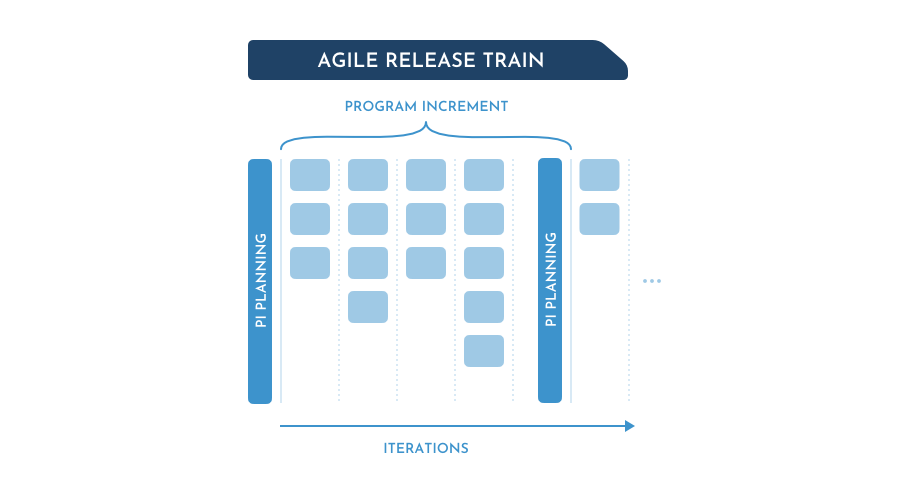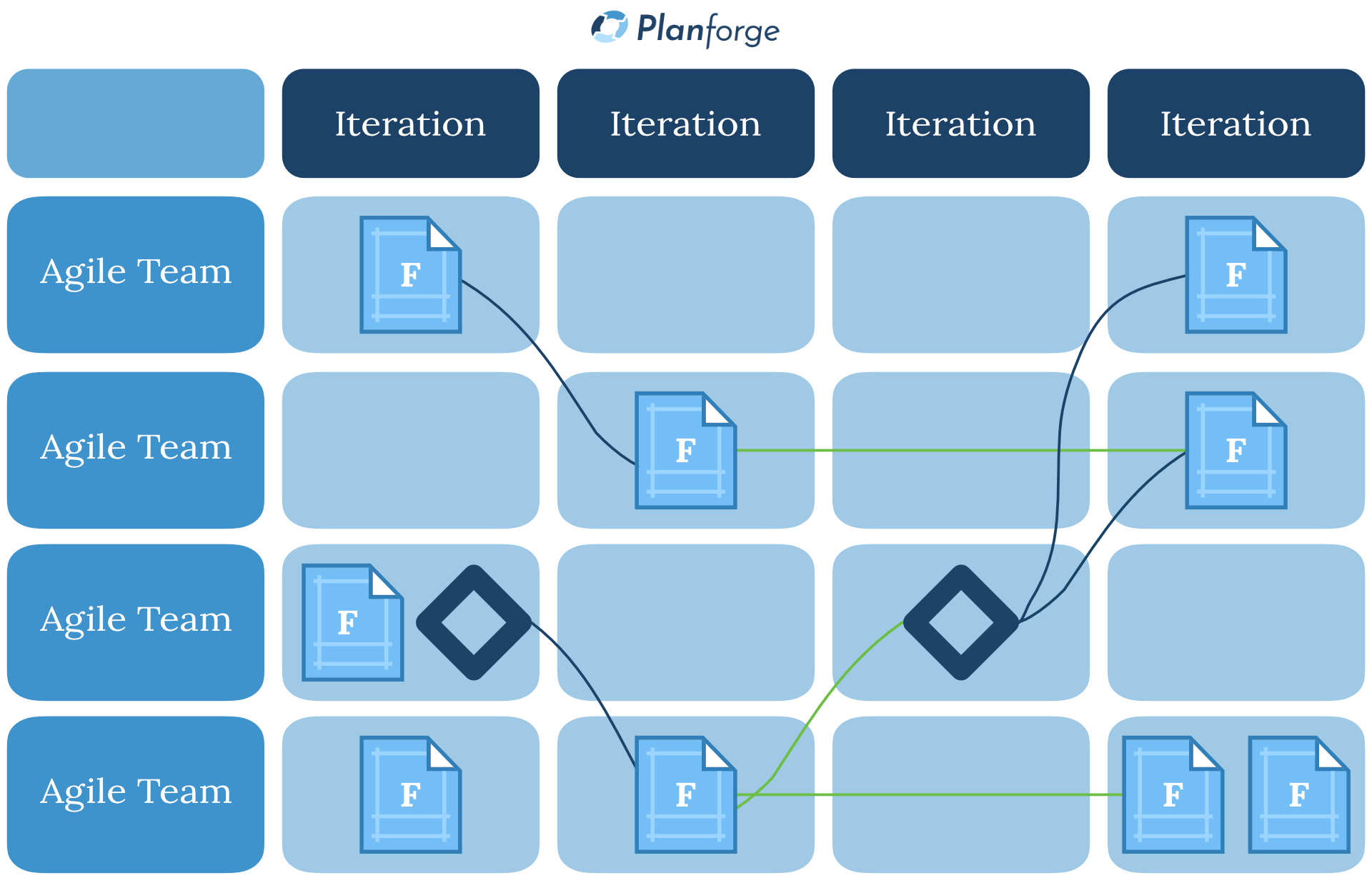Table of Contents
- 1. What is PI Planning
- 2. SAFe® PI Planning
- 3. The PI Planning Process
- 3.1. Inputs
- 3.2. Preparation
- 4. The PI Planning Agenda
- 5. Goals & Outputs of PI Planning
- 5.1. ART Planning Board (Program Board)
- 5.2. PI Objectives
- 6. Roles and Responsibilities
- 7. Benefits of PI Planning
- 8. Advantages of a PI Planning Tool
1. What is PI Planning
Program Increment Planning or PI Planning is a recurring event of the entire Agile Release Train that takes place every 8 to 12 weeks.
The ultimate goal of the PI Planning event is to align the ART around a shared vision and create a plan for the upcoming Program Increment.
The entire Agile Release Train – including stakeholders, project owners, and agile teams – comes together to review the PI features. Following a standardized agenda, teams define the value they aim to deliver in the upcoming Program Increment by developing a plan and set of objectives.
"PI Planning ensures that the planned work for the program increment is aligned with the business objectives, adds value to the organization, and contributes to its success. It empowers organizations to embrace agility."
– Dieter Freismuth
SAFe® Program Consultant (SPC)
2. SAFe® PI Planning
Simply put, Program Increment Planning is a mandatory, cadence-based event of the Scaled Agile Framework®.
The development timeline in Scaled Agile Framework is divided into a sequence of iterations called Program Increments (PI). Each Program Increment starts with the PI Planning event.
"PI planning is essential to SAFe: If you are not doing it, you are not doing SAFe."
– © Scaled Agile, Inc.
SAFe and Scaled Agile Framework are registered trademarks of Scaled Agile, Inc.
After the PI Planning event, there are four execution iterations. Finally, the Program Increment concludes with the IP (Innovation and Planning) iteration, which incorporates PI Planning for the upcoming Program Increment. The recommended length of an iteration in SAFe is typically one or two weeks.
Learn more in our related article: How SAFe Drives Business Agility
3. The PI Planning Process
3.1. Inputs
PI Planning has three main inputs:
Business Context
Roadmap & Vision
Highest Priority Features
The company vision provides valuable business context for PI Planning. Identifying the company's vision and goals and mapping them to business needs is key to effective PI Planning. It includes considering the target audience's needs and ensuring alignment with business goals.
Mapping vision and goals to business needs helps save time by determining the most efficient way to achieve goals. Another important input is the identification of high-priority features in the ART backlog.

"PI Planning provides teams with confidence in what they can achieve in the next program increment. Management can see the value teams are currently creating based on their vision and roadmap. After two days, everyone is on the same page and shares a common vision."
– Axel Straschil
SAFe Consultant & Trainer (SPC)
2Corn business consulting
3.2. Preparation
To ensure a successful PI Planning event, it is essential to focus on three key areas of preparation:
-
Organizational readiness: Ensuring strategic alignment across the entire ART, fostering a shared understanding of the process, and establishing agreement on priorities.
-
Content readiness: Conducting management briefings to define a clear vision and business context and preparing backlog features and other relevant information.
-
Logistics readiness: Properly preparing the facility, materials, and technology required for the event’s successful execution.
4. The PI Planning Agenda
SAFe PI Planning follows a standard agenda that includes a specific set of core items. The typical meeting duration is two days.
The first day of PI Planning begins with a presentation of the business context and vision, providing a common understanding of the business goals. Agile teams later engage and collaborate in breakouts to create iteration plans, add features and dependencies to the program board (ART planning board), and define team objectives for the next Program Increment.
On the second day, teams present their results, receive feedback, and adjust their PI objectives if necessary. Ultimately, the primary outputs of the event are the program board and PI objectives.
Figure 2 illustrates the standard PI Planning agenda based on Scaled Agile, Inc. Each item on the agenda and the roles involved are explained in detail below.
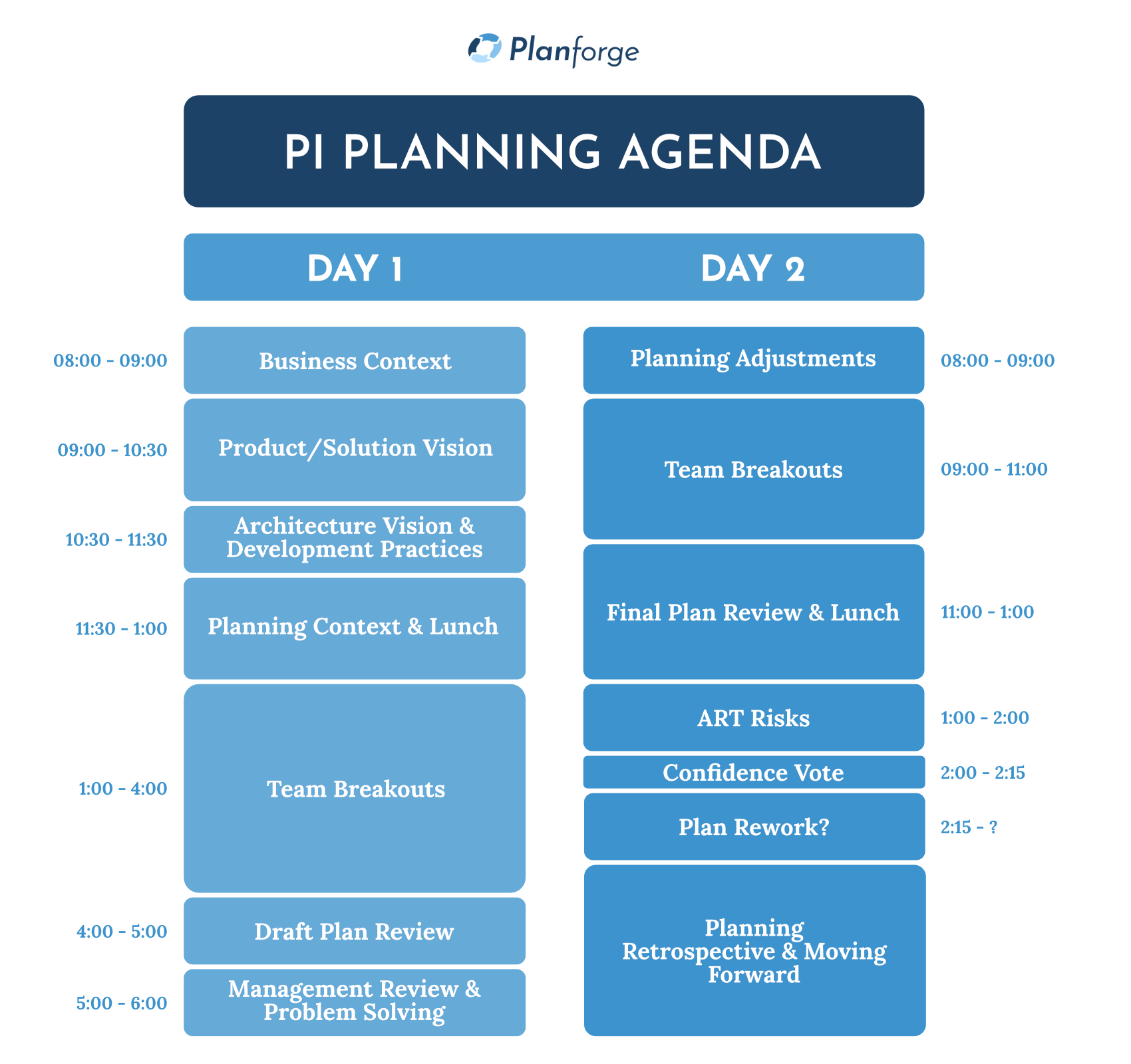 Figure 2: Agenda – Image created following Scaled Agile, Inc.- scaledagileframework.com.
Figure 2: Agenda – Image created following Scaled Agile, Inc.- scaledagileframework.com.
SAFe and Scaled Agile Framework are registered trademarks of Scaled Agile, Inc.
4.1. Day 1
- Business context presentation: Business owners present the portfolio vision and assess the current state of the business to guide teams in planning the following PI. They also explain how well existing solutions meet current customer needs.
- Product/solution vision: The product manager/management presents the product and solution vision.
- Architecture vision and development practices: A system architect introduces the architecture vision. A senior development manager may also present changes in development for the upcoming PI.
- Planning context: The release train engineer (RTE) introduces the planning context, consisting of the process and expected outcomes.
- Team breakouts: Agile teams prepare each iteration of the program increment which involves creating backlog items (=stories) and estimating effort in story-points. The initial team PI objectives are a key result of this process. Each team adds features and dependencies to the program board (ART planning board).
Teams also identify risks at this point and whether they commit themselves to a feature or not ('uncommitted objectives' they may not be able to deliver within timeframe). - Draft plan review: Teams present their breakout outcomes to business owners, stakeholders, product management, and the other teams and receive feedback.
- Management review and problem resolution: RTE and management address challenges in the draft plans to resolve issues. The RTE facilitates this process. He actively engages key stakeholders to ensure that teams make achievable decisions.
4.2. Day 2
- Planning Adjustments: Management presents first-day results and changes.
- Team Breakouts: Teams continue to plan and adjust their iterations and team PI objectives. Finally, business owners assign business value to the resulting PI objectives.
- Final Plan Review: Teams present their outcomes and potential risks. Business owners must accept their plan; only then can they present their PI objectives.
- ART PI Risks: The ART discusses risks and categorizes them as resolved, owned, accepted, or migrated.
- Confidence Vote: At the end of PI Planning, after dependencies have been resolved, and risks have been addressed, a confidence vote is conducted.
Teams vote on how likely they are to achieve their objectives. People vote using five fingers, which is why a confidence vote is also known as "fist of five." If someone is concerned about achieving the objectives, they vote with two fingers or less. Teams discuss concerns until the average is three fingers or more. - Plan Rework: Teams adjust PI objectives if necessary.
- Planning Retrospective and Moving Forward: The Release Train Engineer evaluates the event itself, capturing lessons learned.
"Teams leave the PI planning event with a prepopulated iteration backlog for the upcoming PI. (…) Most importantly, the ART executes the PI, tracking progress and adjusting as necessary as new knowledge emerges.
Execution of the PI begins with all the teams conducting planning for the first iteration, using their PI plans as a starting point."
– © Scaled Agile, Inc.
SAFe and Scaled Agile Framework are registered trademarks of Scaled Agile, Inc.
Figure 3 shows what confidence voting looks like in an Enterprise Agile Planning tool:
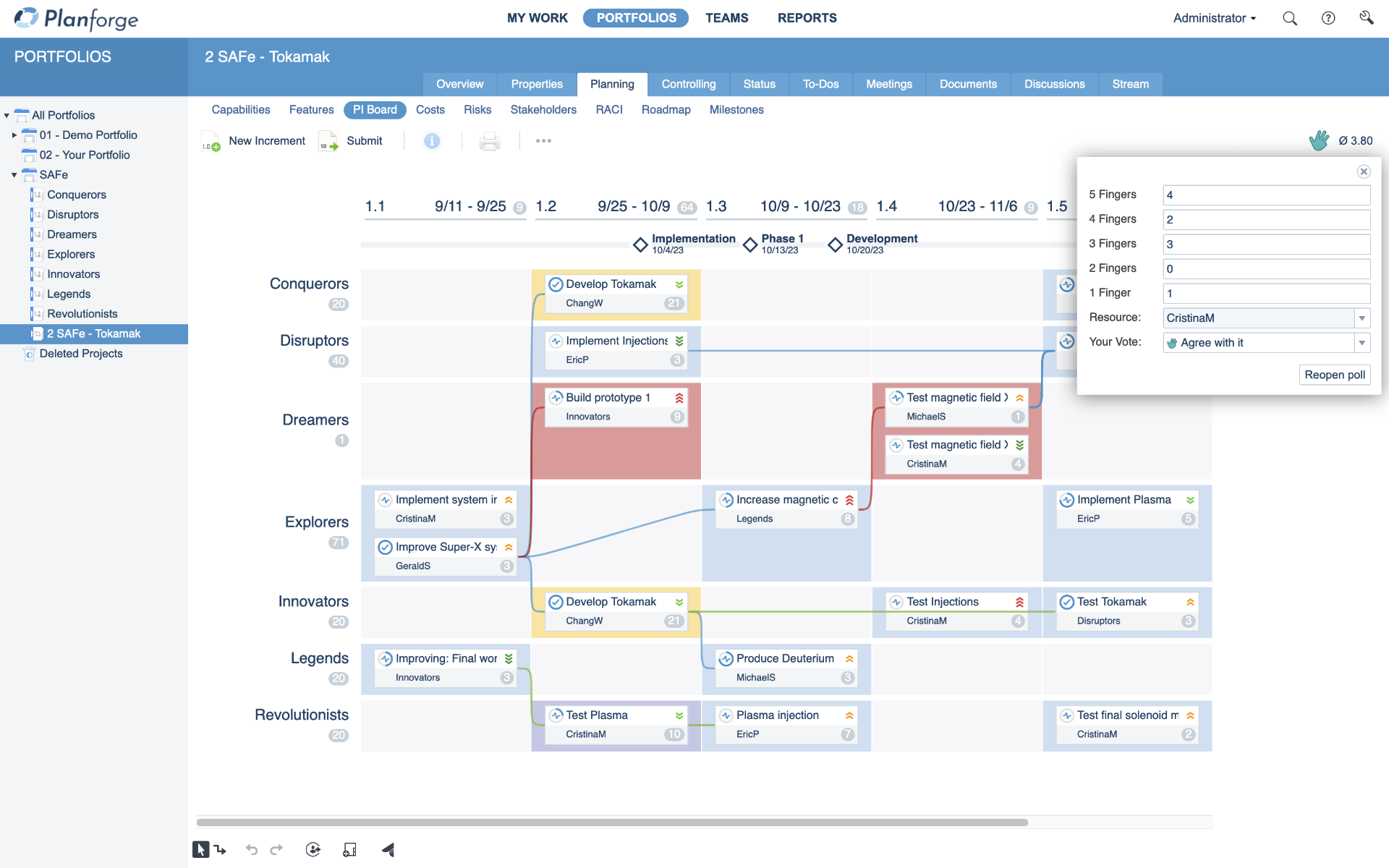 Figure 3: The program board with confidence voting in Planforge
Figure 3: The program board with confidence voting in Planforge
5. Goals and Outputs of the PI Planning Event
When PI planning is successful, it provides two primary outputs:
- The PI objectives
- The SAFe program board (ART planning board)
As mentioned, the primary goal of the PI Planning event is to synchronize the Agile Release Train around a unified vision and develop a holistic plan for the upcoming Program Increment.
Creating alignment among agile teams and fostering a shared vision is great for cultivating strong relationships and building trust. PI Planning actively engages agile teams in the process of planning and prioritizing features.
5.1. The SAFe® Program Board (ART Planning Board)
The program board (ART planning board) is an output of PI Planning and an essential tool for SAFe execution. It visually represents the work commitments for the following program increment.
*The SAFe program board is now called ART planning board in SAFe 6.0 and may also be known as PI Planning board.
It enhances transparency and increases flexibility, enabling teams to minimize delays and reduce dependencies.
The program board helps teams to identify whether all processes are aligned with the defined plan (or not) and effectively communicates the PI plan to the entire organization.
Note that the program board is a facilitator for the process and the visualized plan itself.
The SAFe program board displays the following items:
- Features / Feature Delivery Dates
- Feature Dependencies
- Milestones
- Rows: Represent agile teams of the ART
- Columns: Visualize sprints (PI Iterations)
- Notes: Describe features and milestones of agile teams
- Strings: Show feature dependencies
The Program Board in Planforge's Enterprise Agile Planning Tool:
1: Agile Teams | 2: Velocity | 3: Milestones | 4: Confidence Votings | 5: Features | 6: Backlog | 7: Dependencies
The Program Board during PI Planning
The ART creates the program board during PI planning. It is crucial to help teams manage dependencies across the PI throughout the process. The program board provides teams with a clear understanding of the detailed work, its alignment with the organization's objectives, and its dependencies with other tasks.
By using the program board, teams can identify required tasks and, most importantly, any potential issues that could cause delays.
5.2. PI Objectives
Team PI objectives are agreed upon during the PI Planning event. They capture the business and technical goals that ARTs and teams aim to achieve in the upcoming Program Increment. Team objectives are later aggregated into ART PI objectives to refine the roadmap.
PI objectives usually consist of two types:
- Committed objectives: These are the goals that teams are fully committed to achieving within the plan. Well-defined stories and tasks support them, and the team is confident they can achieve them.
- Uncommitted objectives: Teams include these goals in the plan but do not fully commit to them because of risk or uncertainty.
"In the Scaled Agile Framework, short-term commitments are critical to improve alignment and trust between stakeholders and development. PI objectives are used to communicate these commitments."
– Dieter Freismuth
SAFe® Program Consultant (SPC)
6. PI Planning Roles and Responsibilities

Release train engineers support agile teams. As servant leaders, RTEs help teams deliver value and drive continuous improvement. Release train engineers must have a deep understanding of how to scale lean and agile practices.

As key ART stakeholders, business owners have primary technical and business responsibility. Although agile teams are self-managed and self-organized, business owners still provide leadership and intent with a vision and mission. They assist with coaching, while execution authority is decentralized to the ART itself.

The product manager owns feature priorities during PI Planning. He defines the solution itself and provides input on how to add value that satisfies customer needs. Thus, the product manager provides the specific ART context. His input is critical to the solution's success as he guides it through the entire product life cycle. More complex solutions may require a product management team.

By defining the architectural vision, system architects align ARTs around a shared vision and ensure a common direction.

Like the RTE, the SAFe scrum master is a servant leader and coach. He supports teams and Agile release trains throughout the process to meet delivery goals by providing coordination, coaching, and mentoring.

The product owner is part of the agile team and is also responsible for aligning the team backlog with customer and stakeholder needs.

The development manager is responsible for product/solution quality.
7. Benefits of PI Planning

"SAFe is ideal for complex product development: It is scalable, provides space for innovation, and leverages collective intelligence. The PI Planning event creates room for decentralization and self-direction, automatically generating necessary knowledge."
– Axel Straschil
SAFe Consultant & Trainer (SPC)
2Corn business consulting
At the end of the PI planning event, teams return with their prepared team backlog for the upcoming Program Increment. They carry their team’s iteration plans, PI objectives, and risk assessments to their workspaces.
Scaled Agile, Inc. points out the following business benefits of PI Planning:
- Establishing face-to-face communication among all team members and stakeholders
- Building the social network the ART depends upon
- Aligning development to business goals with the business context, vision, and team & ART PI objectives
- Identifying dependencies and fostering cross-team & cross-ART collaboration
- Fast decision-making
© Scaled Agile, Inc.
SAFe and Scaled Agile Framework are registered trademarks of Scaled Agile, Inc.
8. Advantages of a PI Planning Tool
With a PI planning tool, managers and contributors gain access to progress updates, real-time data, and visual representations of the plan. This enables informed decision-making, bottleneck or risk identification, and plan adjustments to ensure successful PI execution.
Enterprise Agile Planning tools often integrate PI Planning to support scaling agile practices within organizations: Tools like Planforge help you manage the whole ART life cycle while seamlessly integrating functionality for portfolio, risk, and strategic management.
Planforge’s hybrid PPM software integrates Enterprise Agile Planning with support for SAFe PI Planning. Scale agile practices beyond individual teams with Planforge.
Planforge also features integrated risk management enabling managers to understand, anticipate, and eliminate potential risks early on. Figure 5 displays the ROAM matrix of Planforge’s Enterprise Agile Planning tool:
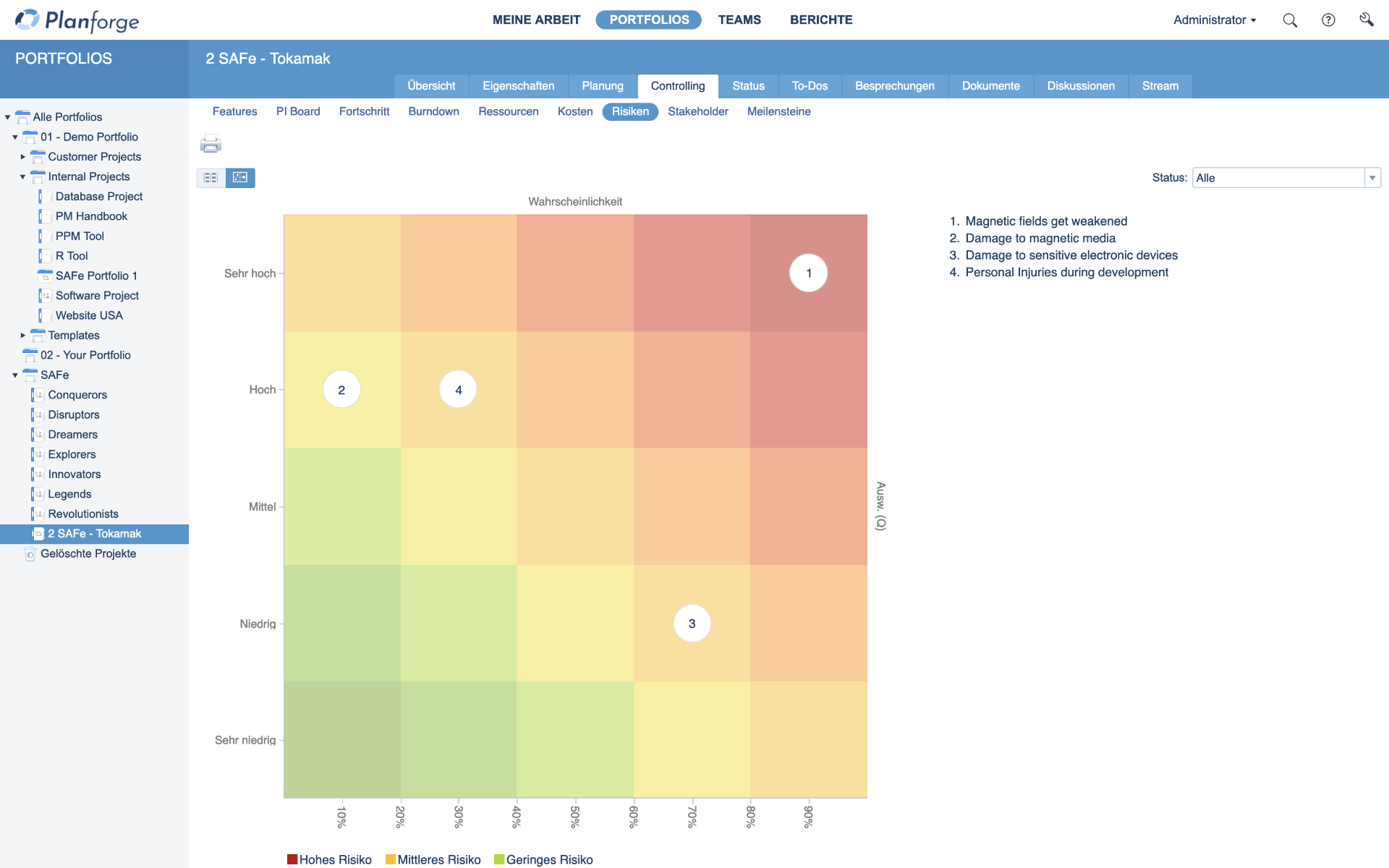 Figure 5: The SAFe-compatible risk management matrix in Planforge
Figure 5: The SAFe-compatible risk management matrix in Planforge
Contact us if you want to support your PI Planning with a modern, hybrid PPM software.








 Jira
Jira
 Confluence
Confluence
 SAP
SAP
 API
API




